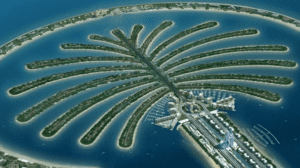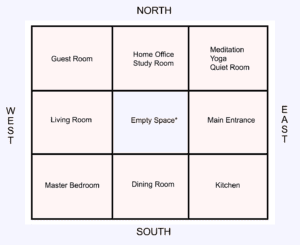Dubai, the dazzling city of skyscrapers, luxury experiences, and innovation, attracts millions of visitors every year. But beneath its shimmering facade lies a fascinating cultural tapestry. While Dubai is a global metropolis, many residents come from countries with deep-rooted traditions like Vastu Shastra, an ancient Indian system of architecture.

What is Vastu?
Vastu, literally translating to “science of dwelling,” emphasizes the harmonious integration of architectural design with natural energies. It dictates the placement of rooms, furniture, and even doorways to create a positive flow of energy (“Purusha”) within a living space.

However, a question arises: How does a city like Dubai, built on a foundation of modern architecture and rapid development, incorporate kshetra principles?
The answer is complex. While some residents might integrate certain Vastu elements into their personal spaces, Dubai’s overall urban design doesn’t strictly adhere to Vastu principles. Here’s why:
- Focus on Functionality: Dubai’s architecture prioritizes space optimization, functionality, and aesthetics. Its iconic skyscrapers, a testament to human ingenuity, are designed to maximize living and working areas while pushing the boundaries of engineering. Vastu’s emphasis on directional alignments and specific room placements might not always be feasible in such a setting.
- Rapid Urbanization: Dubai’s rapid growth necessitates flexibility in building design. Following rigid Vastu guidelines could hinder the city’s ability to meet the ever-increasing demand for residential and commercial spaces.
- Global Melting Pot: Dubai’s diverse population hails from various cultural backgrounds. While Vastu holds significance for some residents, accommodating the architectural preferences of all would be a logistical challenge.
So, does this mean Vastu has no role in Dubai? Not necessarily. Many residents of Indian origin, particularly those who value traditional practices, incorporate Vastu principles within their homes whenever possible. Here are some ways they achieve this:
- Adapting the Principles: Residents might adapt Vastu concepts to their living spaces. For example, the northeast corner, considered auspicious in Vastu, might be used for the pooja room or turned into a meditation space.
- Seeking Expert Guidance: Vastu consultants exist within Dubai’s Indian community. They offer personalized advice on incorporating Vastu elements into existing homes or new properties under construction. This might involve rearranging furniture, using specific color palettes, or placing symbolic objects in specific areas.
- Symbolic Implementation: Some residents might integrate symbolic elements of Vastu without adhering to strict directional guidelines. This could involve using a crystal ball (considered an energy purifier) or placing a picture of a lotus flower (representing peace and prosperity) in a prominent location.
Beyond Vastu: Embracing Other Practices
While Vastu is a prominent practice, it’s not the only way residents create positive energy within their homes. Here are some alternative methods:
- Feng Shui: This Chinese practice, similar to Vastu, also focuses on creating harmonious living spaces. Some Dubai residents might incorporate Feng Shui principles alongside Vastu or independently.
- Space Clearing: Practices like smudging with sage or using crystals for energy cleansing are gaining popularity, particularly among younger generations seeking alternative methods of creating a positive environment.
- Biophilic Design: This design philosophy emphasizes incorporating natural elements like plants and sunlight into living spaces, creating a sense of connection with nature and promoting well-being. Biophilic design principles are increasingly being used in modern architecture across Dubai.
The Future of Well-being in Dubai
As Dubai continues to evolve, the concept of creating harmonious living spaces will likely remain relevant. However, the methods residents utilize might shift. Here are some potential trends:
- Technological Integration: Technology could play a role in creating positive energy flow. For example, smart homes might incorporate features that adjust lighting or temperature to create a more balanced environment.
- Holistic Approach: The concept of well-being is likely to become more holistic, encompassing mental, physical, and spiritual aspects. This could lead to a fusion of practices from various cultures, creating personalized approaches to creating harmonious spaces.
- Sustainable Design: Sustainability will continue to be a major focus. This could lead to the integration of eco-friendly materials and design principles that promote both environmental well-being and a sense of connection with nature.
Conclusion
While Dubai’s urban landscape might not strictly follow Vastu principles, the underlying desire to create positive living spaces remains universal. Residents find creative ways to incorporate traditional practices or embrace alternative methods like Feng Shui, space clearing, or biophilic design. Ultimately, Dubai’s approach to well-being in living spaces reflects its dynamic character – a constant evolution that embraces functionality, cultural diversity, and technological innovation. The city acts as a melting pot of ideas, where residents can choose the practices that resonate most with them, creating personalized havens within the bustling metropolis.
Here are some additional points to consider:
- The Impact of Developers: While individual residents might incorporate Vastu principles, large-scale developers typically prioritize functionality and market appeal in their designs. However, as the concept of well-being gains traction, developers might explore incorporating biophilic design elements or offering customizable layouts that allow for some degree of Vastu adherence.
- The Role of Education: As awareness of Vastu and other well-being practices grows, educational initiatives could play a role. Workshops and seminars could equip residents with the knowledge to incorporate these practices into their existing homes or future purchases.
- The Evolving Landscape: Dubai’s rapid development ensures its urban landscape will continue to change. Whether through technological advancements, a growing focus on sustainability, or a fusion of cultural practices, the city’s approach to creating positive living spaces will likely remain fluid and ever-evolving.
In essence, Dubai offers a fascinating microcosm of how well-being practices adapt within a modern, globalized city. While Vastu might not be the dominant force shaping Dubai’s architecture, the underlying desire for a harmonious living environment remains a constant thread. As the city continues to grow and transform, it will be interesting to see how residents and developers creatively integrate functionality, cultural preferences, and well-being practices to shape the future of living spaces in Dubai.

